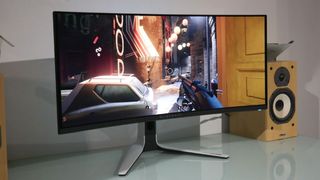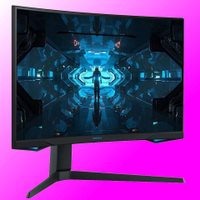Samsung's new microLED TVs are five million times faster than your gaming monitor
That's two nanoseconds response times, if you were wondering.

You know how OLED panels make LCD monitors look like slugs when it comes to response times? Well, you might want to sit down. Because Samsung's new microLED TV is 500,000 times faster than its latest OLED panels.
Specifically, Samsung says its new MicroLED CX panels, just announced at CES, are good for 2 nanosecond response times. That compares with the 0.1ms pixel response the Dell Alienware 34 OLED is rated at, which of course uses a Samsung Quantum Dot OLED panel.
If nanosecond sounds like the natural progression from millisecond, it's worth remembering how big a gap there is between the two metrics. Milliseconds are of course one thousandth of a second. Nanoseconds? That'll be one billionth of a second. All of which means that this Samsung micoLED panel is five million times faster than a 1ms LCD monitor.
The new Samsung microLED CX's pixels respond in two billionths of a second. Which is to all intents and purposes, instantly. As far as pixel response goes, it's end game. Job jobbed. Any further improvements will be irrelevant. You'd never sense them.
Further specs are a bit thin on the ground for now, but we'll assume the sets are all 4K, which thus far is the norm for microLED TVs. Samsung has said that refresh rates are set at 240Hz and that the screen-to-body ratio hits an impressive 99.9%. In other words, these TVs have virtually no bezels at all.
Of course, microLED has long been pretty promising but as yet also painfully pricey screen technology. As in $50,000, $100,000, that kind of pricey. Size has also been an issue, with microLED screens tending to come in above 100 inches.

Samsung says the new CX line will be cheapest microLED sets yet and no doubt that is true. But given existing microLED pricing, there's plenty of scope for cheapest yet but still off the charts compared to conventional displays. The size thing, however, Samsung does seem to have cracked, with panel options starting as small as 50 inches from later this year.
The biggest gaming news, reviews and hardware deals
Keep up to date with the most important stories and the best deals, as picked by the PC Gamer team.
That's still a bit over the top for a PC monitor, but the progression is obvious enough. Bit by bit, microLED is marching towards the size and price point that would make it viable for a PC monitor.
It seems very likely that microLED will eventually be the technology of choice for PC monitors—at least for 2D flat panel displays. They have all the advantages of OLED, including per-pixel lighting, but even better response times and no burn-in worries.
It's just pricing and proportions that need to be fixed and, at the very least, Samsung is moving in the right direction. With OLED finally making the jump onto the desktop of late, it will be interesting to see if it can replace LCD as the default panel technology for PC monitors or if microLED can close the cost gap quickly enough to make OLED redundant before it even has a chance to become properly established. Watch this space.
Best gaming monitor: Pixel-perfect panels
Best high refresh rate monitor: Screaming quick
Best 4K monitor for gaming: High-res only
Best 4K TV for gaming: Big-screen 4K PC gaming

Jeremy has been writing about technology and PCs since the 90nm Netburst era (Google it!) and enjoys nothing more than a serious dissertation on the finer points of monitor input lag and overshoot followed by a forensic examination of advanced lithography. Or maybe he just likes machines that go “ping!” He also has a thing for tennis and cars.
Most Popular








